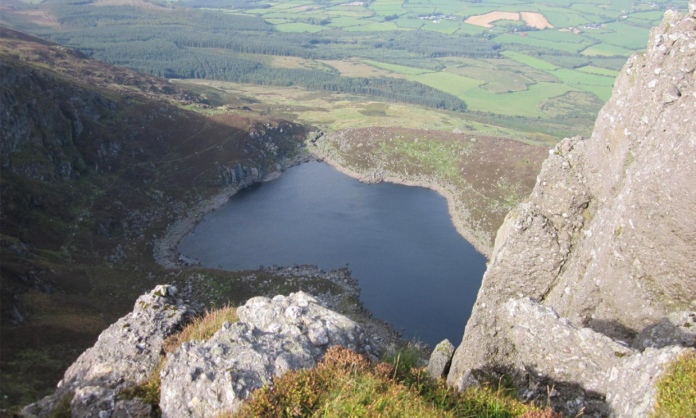By Kilrossanty Remembers, local history group
This spring marks 280 years since the capture and execution of William Crotty, the famed highwayman better known as Crotty the Robber. Crotty, somewhat of a Robin Hood figure in folklore, enjoyed an estimated five-year criminal reign in Waterford, Kilkenny and Tipperary from his stronghold in the Comeragh mountains.
Arrested on the 16th of February 1742, he was judged guilty of being a “Tory, Robber and Rapparee”, Crotty was hanged one month later on the 18th of March. For good measure, his severed head was stuck on a spike outside the prison gaol in Waterford city to serve as a reminder of the inevitable fate that awaited would-be criminals. It is said that the hair on Crotty’s head did not decay with the flesh but instead grew into a haunting sight on the skull.
Downfall
Accounts of his capture vary, but one common thread appears in all: betrayal by his former confidant David Norris. Folklore states that having given shelter to Crotty in his home, Norris got him drunk, stole his dagger, wet his gunpowder, and then informed the authorities of the felon’s whereabouts.
A more official version of Crotty’s downfall is documented in a magazine from the time, Pue’s Occurrence. This publication states that Crotty was captured on 16th February 1742 after a 48-hour standoff holed up in his cave alongside Loch Gorra, now known as Crotty’s Lake. Leaving all his clothes behind him, he almost managed to slip through the ring of soldiers that had encircled his hideout. However, he was spotted and trailed by Norris and a Mr Hearn. The duo then found him asleep in a derelict cabin a mile and a half from his cave. Consequently, he was brought into Waterford under a heavily armed guard and executed within a month.
Gunshot Wound?
While no gunshot wound on Crotty is mentioned in the Pue’s Occurrence report, many of the retellings of the outlaw’s capture do reference a bullet wound to the mouth at one point or another. For instance, an 1851 book by John Edward Walsh book states that during his capture, Crotty was “disabled by a shot in the mouth.” Furthermore, a version in local historians Sean and Sile Murphy’s book, Waterford: Heroes, Poets & Villains, says that he was nearly captured on one occasion by Hearn, having been shot in the mouth. Instead, a dense fog quickly descended and helped mask his laboured retreat through the Comeraghs.
Interestingly, the folklore around Crotty being shot in the mouth upon capture is likely tied to a darker tale attributed to him. This tale depicts Crotty and Norris spying in the window of a house, watching an unsuspecting husband and wife eating their dinner. As the man was lifting a potato to his mouth, Crotty made a bet with Norris that he could fire a bullet past the man’s mouth before the potato reached it. Crotty then shot the man dead with the bullet piercing his mouth while the potato was at his lips.
Thus, it would seem that the addition of Crotty being disabled in the mouth during his capture in many of the folklore tellings is likely a karmic twist added throughout the centuries.
Cultural Legacy
Crotty’s memory remains strongly deep-rooted in the Comeraghs, and his cultural impact has seen his name marking many of the mountain’s features. There is, of course, Crotty’s Lake. His den is still known today as Crotty’s Hole. Crotty’s Stool is perched atop the cliffs overhanging the lake. Legend says that it was from this point where Crotty’s pregnant wife jumped to her death as the authorities hounded her across the mountainside.
There is also a Crotty’s Rock near Crough. While at the back wall of Coumshingaun Lake, there is a cavern known as Crotty’s Stable. Here, it was said, Crotty hid a stolen horse. The spirit of this horse is supposed to still frequent its old holding, and its wild neigh is said to be heard in the depths of a dark, still night.
Interestingly, a separate legend tells of a horse that emerges from the waters of Coumshingaun every seven years and shakes itself dry on the bank. It is said that if you dig where the horse shakes itself, you will find Crotty’s gold.
Hidden Bounty
Crotty’s gold is of course further fuel to the flames that burn brightest in Crotty’s mythology.
Folklore tells that as the condemned man stepped upon the gallows, he addressed the gathered crowd, asking was there anyone present from Comeragh. When he got no response, he reportedly replied, “I can see you, but I know you are afraid to speak.” Then as the rope was being fitted around his neck, he spoke his last words, revealing the location of his buried haul.
Several versions of where this stash is located survive. Some state that the treasure is buried under a specific stone and marked by a horseshoe. Another speaks of a rock where one could turn a pair of horses and plough, while yet another tells of a stone that intersects three bushes and on which you could turn a stagecoach.
But perhaps the most frightening of the many varied legends of Crotty’s shadow which still linger over the Comeraghs is one of a haunting figure that can still be sighted around the lakes of the mountain range or by people walking the roads at night. This phantom is tall, dark clothed, and moves quickly and confidently on silent footsteps in the mist. Known as the Dark Stranger, it seems Crotty’s spirit still haunts his once-proud stronghold of the Comeraghs.








